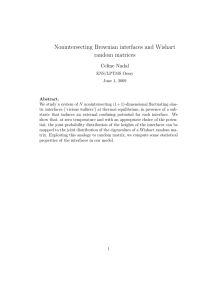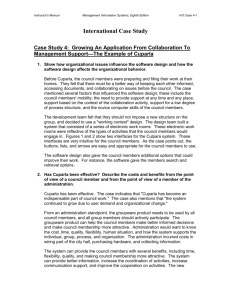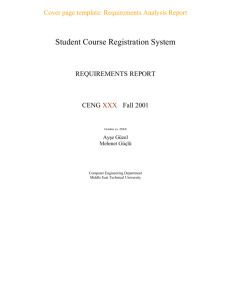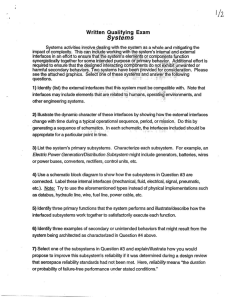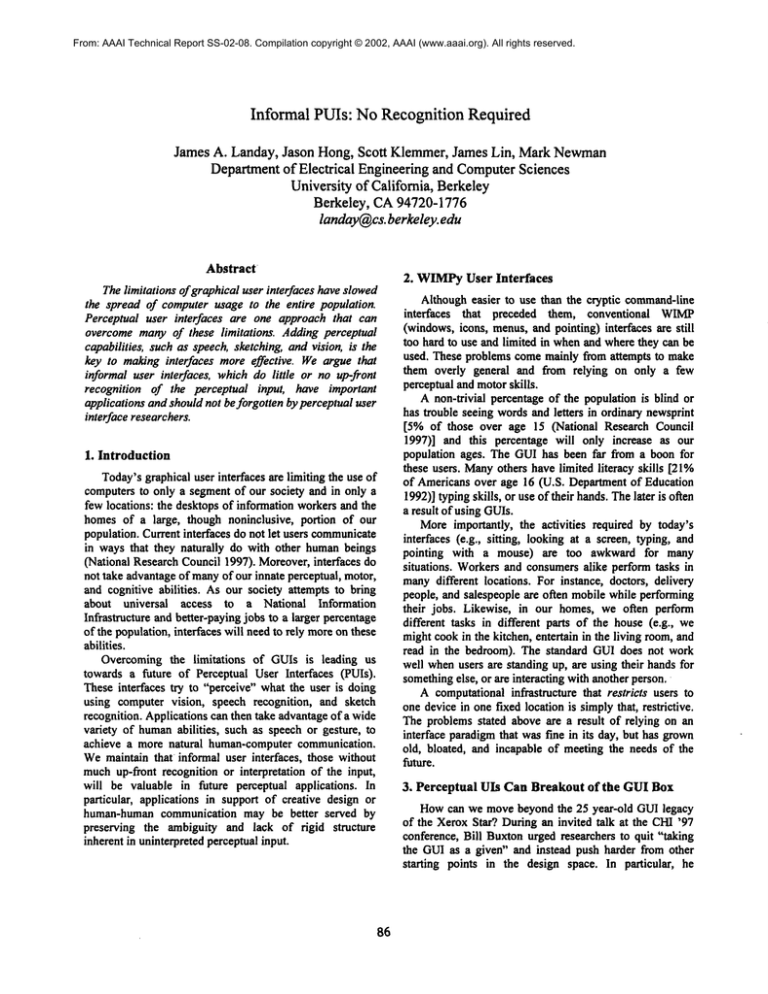
From: AAAI Technical Report SS-02-08. Compilation copyright © 2002, AAAI (www.aaai.org). All rights reserved.
Informal PUIs: No Recognition Required
James A. Landay, Jason Hong, Scott Klemmer,James Lin, MarkNewman
Departmentof Electrical Engineeringand ComputerSciences
Universityof California, Berkeley
Berkeley, CA94720-1776
landay@cs,berkeley, edu
Abstract
The limitations of graphicaluser interfaces haveslowed
the spread of computerusage to the entire population.
Perceptual user interfaces are one approach that can
overcome many of these limitations. Adding perceptual
capabilities, such as speech, sketching, and vision, is the
key to making interfaces more effective. Weargue that
informal user interfaces, which do little or no up-front
recognition of the perceptual input, have important
applications and should not be forgotten by perceptualuser
interface researchers.
1. Introduction
Today’sgraphical user interfaces are limiting the use of
computersto only a segmentof our society and in only a
few locations: the desk’tops of informationworkersand the
homes of a large, though noninclusive, portion of our
population. Current interfaces do not let users communicate
in ways that they naturally do with other humanbeings
(National Research Council 1997). Moreover,interfaces
not take advantageof manyof our innate perceptual, motor,
and cognitive abilities. As our society attempts to bring
about universal access to a National Information
Infrastructure and better-paying jobs 1o a larger percentage
of the population,interfaces will needto rely moreon these
abilities.
Overcomingthe limitations of GUIs is leading us
towards a future of Perceptual User Interfaces (PUIs).
These interfaces try to "perceive" what the user is doing
using computer vision, speech recognition, and sketch
recognition. Applicationscan then take advantageof a wide
variety of humanabilities, such as speech or gesture, to
achieve a more natural human-computercommunication.
Wemaintain that informal user interfaces, those without
muchup-front recognition or interpretation of the input,
will be valuable in future perceptual applications. In
particular, applications in support of creative design or
human-humancommunication may be better served by
preserving the ambiguity and lack of rigid structure
inherent in uninterpretedperceptual input.
86
2. WIMPyUser Interfaces
Althougheasier to use than the cryptic command-line
interfaces that preceded them, conventional WIMP
(windows,icons, menus,and pointing) interfaces are still
too hard to use and limited in whenand wherethey can be
used. These problems comemainly from attempts to make
them overly general and from relying on only a few
perceptual and motorskills.
A non-trivial percentage of the population is blind or
has trouble seeing wordsand letters in ordinary newsprint
[5% of those over age 15 (National Research Council
1997)] and this percentage will only increase as our
population ages. The GUIhas been far from a boon for
these users. Manyothers havelimited literacy skills [21%
of Americansover age 16 (U.S. Departmentof Education
1992)]typingskills, or use of their hands.Thelater is often
a result of using GUIs.
Moreimportantly, the activities required by today’s
interfaces (e.g., sitting, looking at a screen, typing, and
pointing with a mouse) are too awkward for many
situations. Workersand consumersalike perform tasks in
manydifferent locations. For instance, doctors, delivery
people, and salespeople are often mobilewhile performing
their jobs. Likewise, in our homes, we often perform
different tasks in different parts of the house (e.g., we
mightcookin the kitchen, entertain in the living room,and
read in the bedroom). The standard GU1does not work
well whenusers are standing up, are using their hands for
somethingelse, or are interacting with anotherperson.
A computationalinfrastructure that restricts users to
one devicein one fixed location is simplythat, restrictive.
The problemsstated above are a result of relying on an
interface paradigmthat was fine in its day, but has grown
old, bloated, and incapable of meeting the needs of the
future.
3. Perceptual UIs Can Breakout of the GUI Box
Howcan we movebeyond the 25 year-old GUIlegacy
of the XeroxStar.’? Duringan invited talk at the CHI’97
conference, Bill Buxtonurged researchers to quit "taking
the GUIas a given" and instead push harder from other
starting points in the design space. In particular, he
encouraged researchers to movetowards the goal of an
"invisible computer."
One such push has come from researchers working on
perceptual user interfaces (PUIs) (Pentland and Darrell
1994, Turk 1997, Huanget al. 1995). These interfaces
support natural modesof input by having the computertry
to "perceive" what the user is doing. The perceptual
processing has generally been restricted to speech
recognition and computer vision. This definition of
perceptual user interface is overly restrictive. Humans
perceive sounds and light and then recognize them as
speechand visual objects, respectively. Likewise,using our
visual system we perceive handwritten words and sketches
and then recognize what the symbols mean. People are
comfortable using their sketching and writing skills
everyday for manydifferent tasks. Weare missing an
opportunity to bring natural interfaces to morepeople by
neglecting these modes.Thus, the definition of perceptual
user interface should also include interfaces using
handwrittenand sketched input.
4. Informal and Formal User Interfaces
Animportant but orthogonal question is howand when
these natural modes should be interpreted. Immediate
recognition imposesstructure on the input that can often
get in the way during creative or communications-oriented
tasks, such as brainstorming(Moranet al. 1995) or design
(Landay and Myers 2001). An alternative,
informal
approachhas recently gained research interest. Weuse the
term informal user interfaces to describe interfaces
designed to support natural, ambiguousforms of humancomputerinteraction without muchup-front recognition or
transformation of the input. Informal interfaces are a
reaction to the "overly restrictive computationalformats"
(National Research Council 1997) inherent in current
applications.
These restrictive interfaces are often a result of
tradition. Computershave found their greatest success in
applications where they have replaced humansin tasks at
which humans are poor, such as performing complex,
redundant mathematical calculations, or storing and
searching large amountsof data. Weuse the term formal
user interfaces to describe these precision-oriented
interfaces and perceptual interfaces that try to recognize
humaninput immediately.
As computers grow more powerful, less expensive, and
morewidespread,we expect themto assist us in tasks that
humansdo well, such as writing, drawing, and designing.
Unfortunately, the historical strengths of computershave
led to a design bias towards precise computation,and away
from the more human properties of creativity
and
communication.Consequently, interfaces are designed to
facilitate structured input rather than natural human
87
communication,which consists of the imprecise modesof
speaking,writing, gesturing, and sketching.
Most of the work on perceptual user interfaces and
sketch understanding has been biased towards precise
computationand so tries to unambiguously
interpret natural
input as soon as possible and structure the data in a form
that is best for the computer.Thereare several domainsthat
are better served by a moreinformal approach.
4.1 Informal Sketching UIs
Design is one domainwhere an informal approach may
be moreappropriate. Current design applications generally
require the user to drag objects from a "palette" to a
"canvas" on which they are manipulated using a mouse.
Theseobjects, such as lines and circles, are often placed
very precisely with an exact location and size. This
precision makesit easy for the computerto represent the
objects in the system. A precise representation is also
important for some tasks, such as constructing the
mechanical drawings for a part that is to be machined.
However,this drawinginterface is quite different fromthe
way we construct drawings without computers: we often
sketch rough, ambiguousdrawingsusing pencil and paper.
Sketching is one mode of informal, perceptual
interaction that has been shownto be especially valuable
for creative design tasks (Gross and Do1996, Wong1992).
For designers, the ability to sketch ambiguous
objects (i.e.,
those with uncertain types, sizes, shapes, and positions)
rapidly is very importantto the creative process. Ambiguity
encouragesthe designer to explore moreideas in the early
design stages without being burdened by concern for
inappropriate details such as colors, fonts, and precise
alignment.Leavinga sketch uninterpreted,or at least in its
rough state, is the key to preserving this fluidity (Goel
1995).
In this early phase, ambiguity also improves
communication,both with collaborators and the target
audienceof the designedartifact. For example,an audience
examininga sketched interface design will be inclined to
focus on the importantissues at this early stage, such as the
overall structure and flow of the interaction, while not
beingdistracted by the details of the look, such as, colors,
fonts, and alignment. Whenthe designer is ready to move
past this stage and focus on the details, the interface can be
recreated in a more formal and precise way. Wehave built
several designtools that incorporatethis style of interface.
SILK(Landay and Myers 2001) is targeted at graphical
user interface design and DENIM
(Lin et al. 2000)
targeted at website design (see Figure 1). DENIM
has little
built-in sketch recognition.
¯.:~.~..:...
.......~
Figure 1. DENIM
is a sketch-based webdesign tool that takes advantageof an informal user
interface. In DENIM’s
storyboardview, multiple pages and the links betweenthemare visible.
DENIM
tries to group ink on pagesinto links or graphical objects. Recognizinglinks between
items and pages is the only other sketch recognition performedby DENIM.
4.2 Informal Speech Uls
Speechis another perceptual style of interaction that is
starting to becomepopular. Althoughspeech is natural and
inherently human,current speech recognition systems do
not have informal user interfaces. Consider that these
systems generally fail when faced with the ambiguity
inherent in humanspeech (e.g., "recognize speech" vs.
"wreck a nice beach"). Also, current speech recognition
systems try to recognizehumanspeechand translate it into
an accurate, internal represemationthat machinescan deal
with. Thesetools also often require or encouragethe user to
enter a dialog with the machineto correct mistakesas they
occur1. Althoughthis behavior might be appropriate for
purchasingan airline ticket over the phone, it gets in the
waywhenthe user wants to write, design, or brainstorm.
Several systems from the MIT Media Lab Speech
Group had interfaces that could be considered informal
speech user interfaces. For example,this group produceda
handheld speech notetaker that only uses recognition for
n Somedictation systemshavea modethat allows the user to
ignorecorrectionsuntil after the capturesession.
88
organizingthe uninterpreted notes (Stifelmanet ai. 1993).
They also built a paper-based notebookthat synchronizes
uninterpreted speech with handwritten notes (Stifelman
1996). This area warrants moreexploration.
Our research group at Berkeley has developed SUEDE,
a speech UI design tool that uses an informal interface
(Kiemmeret al. 2000). SUEDE
allows designers to record
their ownvoice for system prompts and then plays those
prompts back when testing the interface with test
participants (see Figure2). Duringa test, the designeracts
as a "wizard"by listening to the test participant’s responses
and then "recognizes" and chooses the next legal state of
the interaction. By not using a speech recognizer and an
associated grammar,the wizard can accommodate
multiple
responsesfromthe participant and can use the log of those
responses later in the design process to develop a robust
grammar.
By not requiring the designer to deploy real speech
recognition and synthesis, the interface design process is
expedited in the early stages of design. This allows
designers to makeseveral iterations on their early design
ideas. Fast design iteration has beenfoundto be one of the
keys to creating high quality user interfaces.
Figure2. SUEDE
is a speechuser interface designtool that allows a designerto create, test,
and analyze early interface design ideas. This tool does no speechrecognition or synthesis.
It instead relies on the designer’s ownvoice for promptsand their ownintelligence to
recognizethe end-user’s utterances.
4.3 Informal Handwriting UIs
Handwritingrecognition is another style of interaction
that suffers from some of the same problems as speech
recognition. Again, manysystems try to recognize writing
as the user writes. This might be useful for taking down
someone’s phone number, but begins to get in the way
whenthe user is trying to focus on the task at hand(e.g.,
taking notes in a talk or writing up a newidea). The dialog
with the recognition systemrequires users to focus their
attention on the machine,rather than on their task. Deferred
recognition is one way of dealing with this problem. We
havebuilt systemsthat treat electronic ink as a first-class
type and let users write like they naturally do on paper
(Davis et al. 1999). Others have built similar informal
systems that allow searching of electronic ink (Peon,
Weber, and Cass 1995).
5. Conclusions
Theprimary tenet of workin informal user interfaces is
to bend computersto people’s modeof interaction, not the
other way around. For somedomainsit is clear that the
formal approach imposed by conventional interfaces
presents an obstacle to effective task performance. One
such domainthat we have investigated is user interface
design itself, and this led to our workon SILK(Landayand
Myers2001) and DENIM
(Linet al. 2000), sketching tools
for early stage interface and webdesign, respectively. We
believe that informal speech and handwriting interfaces
may also be useful. Any application that requires
interaction between humansand computers, and in which
absolute precision is unnecessary, could benefit from an
informal approach.
PUIsrelying on a single input modalitywill likely only
see success in limited domains.This is for the samereasons
that GUIsare limited: using only a single input modality
will be goodfor sometasks and not for others. Onthe other
hand, a multimodalinterface with multiple perceptual and
GUIcapabilities will often be morenatural to use (Mignot,
Valet and Carbonell 1993, Walbelet al. 1997). Successful
multimodal user interfaces maysupport uninterpreted
sketches and other informal styles, in addition to
interpreted speech, recognized sketches and other morestudied modalities.
References
Davis, R.C., et al. 1999. NotePals:LightweightNote
Sharing by the Group,for the Group.In Proceedingsof
HumanFactors in ComputingSystems: CHI’99, 338-345.
Pittsburgh, PA.
Goel, V. 1995. Sketches of Thought. Cambridge,MA:The
MITPress.
Gross, M.D.and Do, E.Y. 1996. Ambiguous
Intentions: A
Paper-like Interface for Creative Design.In Proceedingsof
ACMSymposiumon User Interface Software and
Technology,183-192. Seattle, WA.
89
t
Huang,X.; Acero, A.; AUeva,F.; Hwang,M.Y.;Jiang, L.;
and Mahajan, M. 1995. Microsoft Windowshighly
intelligent speechrecognizer: Whisper,in Proceedingsof
1995International Conferenceon Acoustics, Speech, and
Signal Processing,vol. 1, 93-6
Klemmer,S.R.; Sinha, A.K.; Chon,J.; Landay,J.A.;
Aboobaker, N.; and Wang,A., SUEDE:A Wizard of Oz
Prototyping Tool for SpeechUser Interfaces. CHILetters,
2000. 2(2): 1-10.
Waibel, A.; Suhm,B.; Vo, M.T.; and Yang,I. 1997.
Multimodalinterfaces for multimediainformation agents,
in Proceedingsof 19971EEE
International Conferenceon
Acoustics, Speech, and Signal Processing, Vol. 1,167-70.
Wong,Y.Y. 1992. Roughand Ready Prototypes: Lessons
FromGraphic Design. In Proceedings of HumanFactors in
ComputingSystems, 83-84. Monterey, CA.
Landay,J.A. and Myers,B.A., SketchingInterfaces:
TowardMore HumanInterface Design. IEEE Computer,
2001.34(3): 56-64.
Lin, J.; Newman,
M.W.;Hong,J.I.; and Landay, J.A.,
DENIM:
Finding a tighter fit betweentools and practice for
website design. CHILetters, 2000.2(1): 510-517.
Mignot,C.; Valet, C.; and Carbonell, N. 1993. An
ExperimentalStudy of Future q~/atural’ MultimodalHumanComputerInteraction, in Proceedingsof ACM
INTERCHI’93Conference on HumanFactors in
ComputingSystems -- Adjunct Proceedings. 67-68.
Moran,T.P.; Chiu, P.; Molle, W.v.; and Kurtcnbach,G.
1995. Implicit Structures for Pen-BasedSystemsWithina
FreeformInteraction Paradigm.In Proceedings of Human
Factors in ComputingSystems, 487-494. Denver, CO.
National Research Council. 1997. Morethan screen deep:
towardevery-citizen interfaces to the nation’s information
infrastructure. Washington,D.C.: National Academy
Press.
Pentland, A.P. and Darrell, T. 1994. Visual perception of
humanbodies and faces for multi-modalinterfaces, in 1994
International Conferenceon SpokenLanguageProcessing,
vol. 2, 543-6
Peon, A.; Weber,K.; and Cass, T. 1995. Scribbler: A Tool
for SearchingDigital Ink. In Proceedingsof Human
Factors in ComputingSystems, 252-253. Denver, CO.
Stifeiman, L.L 1996. AugmentingReal-WorldObjects: A
Papor-BasadAudio Notebook. In Proceedings of Human
Factors in ComputingSystems, 199-200. Vancouver,
Canada.
Stifelman, LJ.; Arons, B.; Schmandt,C.; and Huiteen, E.A.
1993. VoiceNotes:A SpeechInterface for a Hand-Held
Voice Notetaker, in Proceedings of ACMINTERCHI’93
Conference on HumanFactors in ComputingSystems. 179186.
Turk, M. First Workshop
on Perceptual User Interfaces, ed:
Banff, Alberta, Canada,1997.
U.S. Departmentof Education. 1992. 1992 National,4dult
Literacy Survey. Washington,DC: U.S. Government
Printing Office.
9O


